Table of Contents
- 1 Introduction to Water Storage Solutions
- 2 Why Water Storage is Essential for Preppers
- 3 Assessing Your Water Storage Needs
- 4 Types of Water Storage Solutions
- 5 Maintaining Water Quality in Storage
- 6 Innovative Water Storage Strategies
- 7 Final Remarks on Water Storage Solutions for Preppers
- 8 Frequently Asked Questions
- 8.1 What are the key reasons water storage is crucial for preppers and survivalists?
- 8.2 How can one determine their specific water storage requirements?
- 8.3 What types of water storage solutions are commonly used by preppers?
- 8.4 Why is maintaining water quality important when storing emergency supplies?
- 8.5 Can you suggest any innovative strategies for effective water storage practices?
Views: 2
Introduction to Water Storage Solutions
Importance of Water Storage for Emergency Preparedness
Water storage plays a critical role in emergency preparedness. Having enough water is vital during emergencies as it ensures survival in challenging situations. Without adequate water storage, preppers and survivalists may face severe difficulties when essential resources are scarce or contaminated.
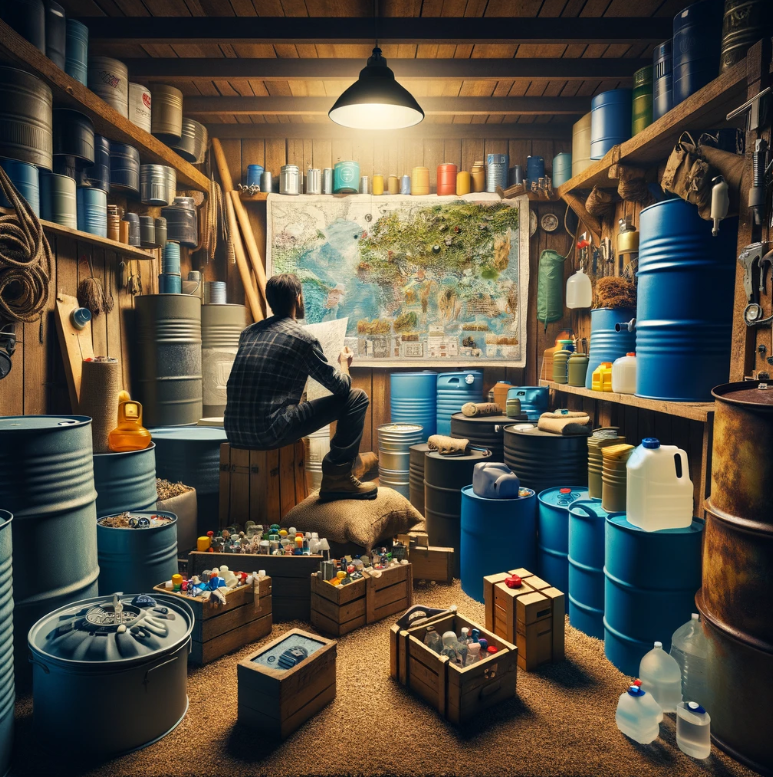
Preppers prioritize effective water storage solutions to enhance their readiness for emergencies. By focusing on finding suitable ways to store water safely, they can better prepare for unforeseen events where access to clean water might be limited or compromised. Implementing reliable water storage systems is key to ensuring that preppers have a sustainable supply of safe drinking water during crises.
Why Water Storage is Essential for Preppers
Explanation of the critical role water plays in survival situations
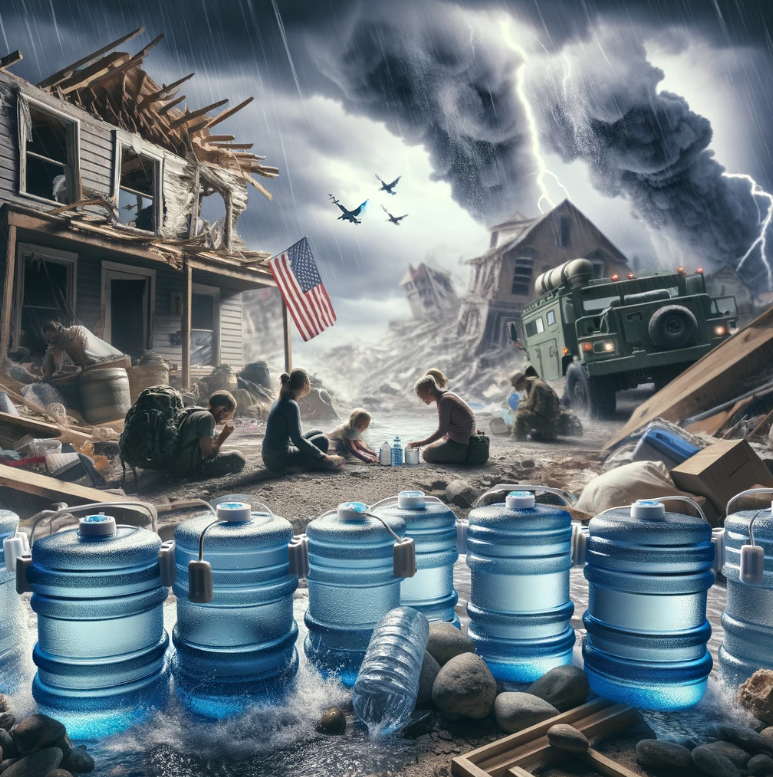
Water is crucial for hydration and keeping the body functioning properly. In survival scenarios, having access to clean water can be a matter of life or death. Without water, the body cannot survive more than a few days.
In emergencies like tornadoes, hurricanes or earthquakes, regular water supplies can be disrupted. Infrastructure failures such those caused by EMPs or even simple malfunctions such as pipe bursts and leaks might also lead to water supply shortages. Having a plan for storing water ensures preparedness for unexpected crises.
Overview of potential scenarios that might necessitate having a water storage plan
Natural disasters have the potential to interrupt access to clean drinking water, making stored reserves vital. Infrastructure breakdowns like damaged pipelines could result in limited or contaminated tap water availability. By having an established system in place beforehand, preppers and survivalists are better equipped to handle unforeseen emergencies effectively.
Assessing Your Water Storage Needs
When preparing water storage solutions for preppers and survivalists, it’s crucial to determine how much water you need per person daily. The general rule is one gallon per person each day, ensuring a three-day supply for drinking and sanitation purposes. For those with medical or dietary requirements, consider storing extra water to meet specific needs.
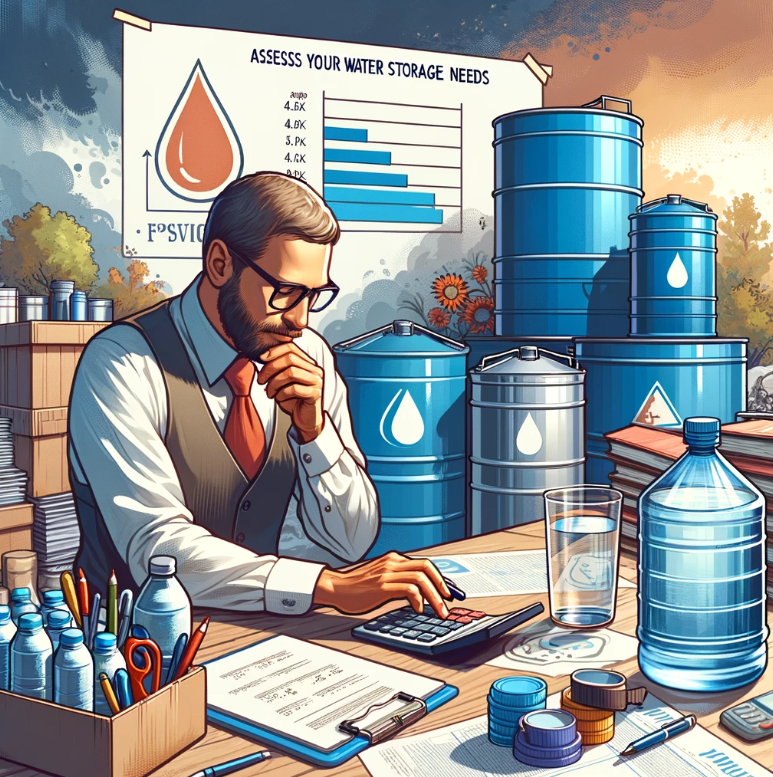
Various factors influence the amount of water needed for storage based on individual circumstances. In hot climates, more water is necessary due to increased perspiration rates. Higher activity levels also require additional hydration, leading to an increased need for stored water. Individuals with special needs might have medical conditions that necessitate more water consumption than the average person.
- Storing one gallon of water per person daily
- Having at least a three-day supply for drinking and sanitation
- Considering extra storage for individuals with specific medical or dietary needs
- Adapting the quantity of water based on climate conditions such as high temperatures.
Types of Water Storage Solutions
Commercially Available Containers
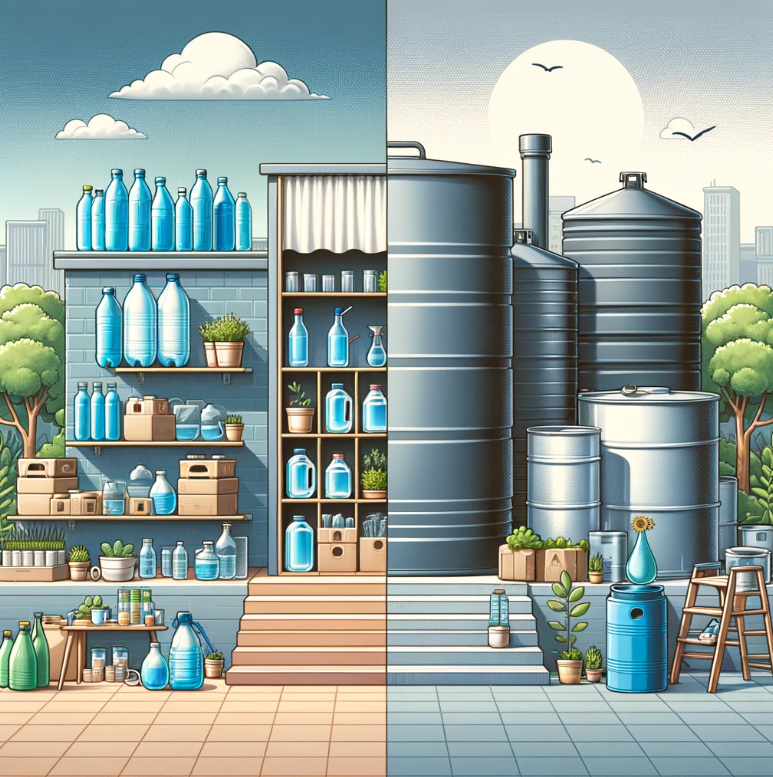
Commercial water storage containers like barrels and tanks are convenient and durable for storing water. These containers are specifically designed to store water safely, ensuring long-term usability. However, they can be costly and may require ample space for installation.
- Pros:
- Convenient storage solutions
- Durable design for water storage
- Cons:
- Expensive option
- Requires additional space
When choosing a commercial container, consider your household’s size and daily water needs. Opt for food-grade plastic or stainless steel containers that are BPA-free to ensure safe long-term use.
DIY Water Storage Options
Repurposing household items like clean soda bottles or juice jugs is a cost-effective way to create DIY water storage solutions. Ensure thorough cleaning and sanitization before using these repurposed containers to prevent contamination risks.
- Repurpose clean, food-grade containers.
- Thoroughly clean and sanitize the containers.
- Avoid using containers previously holding chemicals.
Safety is paramount with DIY options; seal them properly to prevent contamination. Treat stored water with purification tablets if unsure of quality, regularly checking for any damage or degradation signs.
Maintaining Water Quality in Storage
Best practices for keeping stored water safe and potable
Storing water in a cool, dark place away from sunlight is crucial to maintain water storage quality. Avoid storing it near chemicals or contaminants that could compromise its safety. Regularly inspect stored water for any changes in color or smell as signs of contamination.
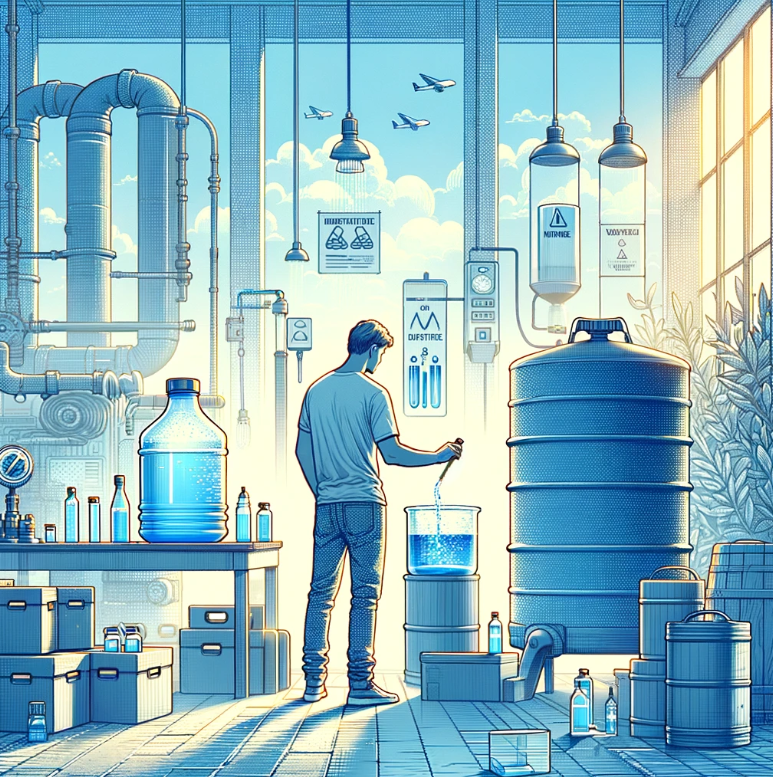
- Store water away from direct sunlight
- Keep it free from chemicals and contaminants
- Check for discoloration or odor regularly
Importance of regular rotation and methods for purifying stored water
Regularly rotating stored water every six months helps ensure its freshness. Purify the water using chlorine bleach or purification tablets to eliminate harmful bacteria. Boiling the water effectively kills bacteria, making it safe for consumption.
- Rotate stored water every six months
- Purify with bleach or purification tablets
- Boil to kill bacteria
Tips for preventing algae and bacterial growth
Prevent algae and bacterial growth in water by using opaque containers or covering transparent ones with a cap to shield them from sunlight exposure. Adding a few drops of bleach to the water container can inhibit bacterial growth, while avoiding potential sources of contamination nearby is essential.
- Use opaque containers
- Add bleach to inhibit bacterial growth
- Avoid contamination sources nearby
Innovative Water Storage Strategies
Discussion on Rainwater Harvesting

Rainwater harvesting is a sustainable water source during emergencies. Install rain barrels or cisterns for future use. Proper water filtration and treatment are crucial before consuming harvested rainwater.
- Pros:
- Sustainable water source
- Cost-effective solution
Atmospheric water generators extract moisture from the air to produce drinking water. These devices offer an alternative in areas with limited clean water access. However, they require electricity to operate effectively.
- Cons:
- Dependence on electricity
- Initial investment cost
Utilize hidden storage spaces like under stairs or within furniture for discreet water storage at home. Built-in shelves and cabinets can be specifically designed for storing water containers while integrating decorative elements that double as functional solutions.
- Key Information:
- Concealed storage options
- Dual-purpose design elements
Innovations in Desalination for Emergency Preparedness
The process of desalination, converting saltwater into drinkable freshwater, presents a groundbreaking solution for water storage challenges, especially in coastal or arid regions. Portable desalination devices, now more accessible and efficient, offer preppers an invaluable resource for ensuring a sustainable water supply during prolonged emergencies where traditional sources may be compromised.
These devices work by removing salt and other impurities from seawater or brackish water, making it safe for human consumption. With advancements in technology, some portable desalination units are now compact enough to be included in personal survival kits, offering a lifeline in situations where freshwater sources are unavailable.
Incorporating desalination into water storage strategies not only expands the potential sources of water in emergencies but also underscores the importance of adopting innovative solutions to address the challenges of water scarcity. By integrating desalination techniques, preppers can further enhance their resilience against the unpredictability of emergency scenarios.
Final Remarks on Water Storage Solutions for Preppers
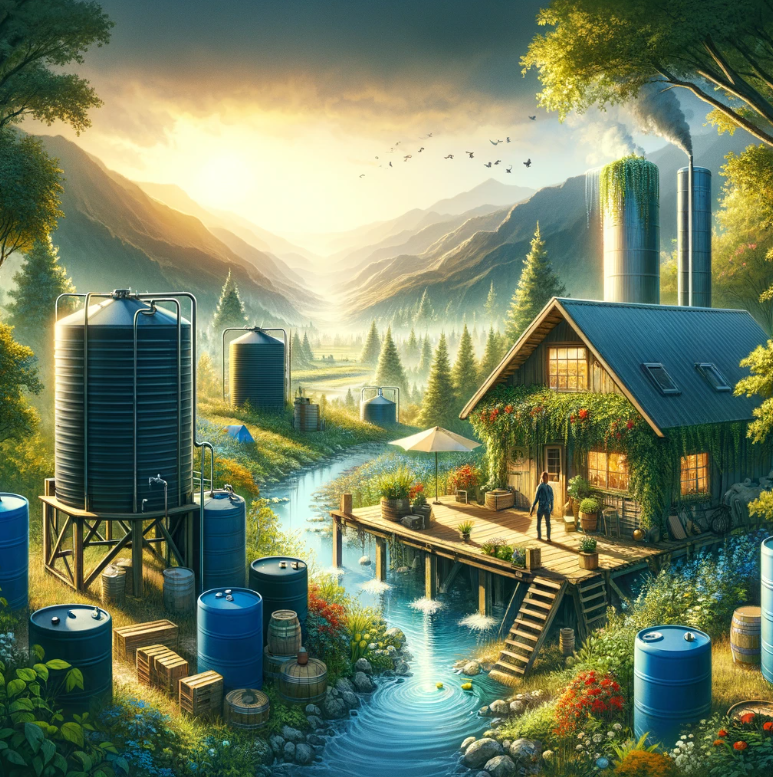
Water storage is a critical consideration for preppers and survivalists. Understanding your water needs, choosing the right storage solutions, and maintaining water quality are vital aspects of preparedness. Innovative strategies can further enhance your ability to secure a reliable water supply in times of need.
For those invested in readiness, continual evaluation and adaptation of water storage methods will ensure sustained preparedness. Stay informed about advancements in water storage technology and regularly review and update your storage systems to meet changing circumstances.
Preparedness is an ongoing process that requires vigilance and proactive measures to safeguard against unforeseen challenges. Keeping some items such as a LifeStraw or other portable water purification methods in your emergency preparedness kits is a good idea! Another thing to consider if you’re thinking about water storage solutions. is long-term food storage solutions.
Frequently Asked Questions
What are the key reasons water storage is crucial for preppers and survivalists?
Water storage is vital for preppers and survivalists to ensure a stable water supply during emergencies, natural disasters, or disruptions in the water system. Having stored water provides security against potential shortages and ensures hydration and sanitation needs are met.
How can one determine their specific water storage requirements?
Assess your water storage needs based on factors like the number of people in your household, daily water usage, climate conditions, and potential duration of emergency situations. Consider storing at least one gallon of water per person per day for a minimum of three days.
What types of water storage solutions are commonly used by preppers?
Commonly used water storage solutions include large-capacity containers like barrels or tanks, portable containers such as cans or collapsible bags, as well as specialized products like rainwater harvesting systems or filtration units designed for long-term use.
Why is maintaining water quality important when storing emergency supplies?
Maintaining water quality in storage prevents contamination and growth of harmful bacteria. Regularly rotating stored water, using proper sealing containers, adding chlorine bleach to prevent bacterial growth, and monitoring cleanliness help ensure the safety of stored drinking-water supplies.
Can you suggest any innovative strategies for effective water storage practices?
Innovative strategies may include utilizing space-saving techniques like vertical stackable containers or incorporating dual-purpose furniture with built-in hidden reservoirs. Exploring alternative sources such as condensation traps or greywater recycling systems can enhance sustainability in long-term emergency preparedness efforts.




Pingback: #1 Best Bug-Out Bag Essentials and Evacuation Plans